[ad_1]
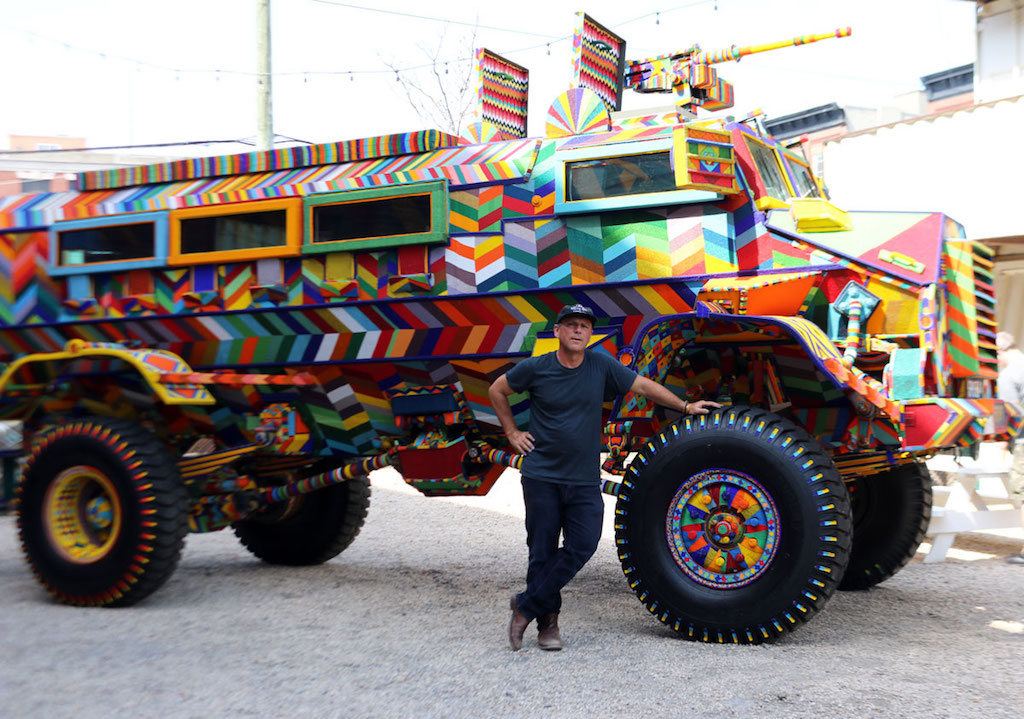
Ralph Ziman by SPOEK 1 at the 1-54 Contemporary African Art Fair.
KATHERINE MCMAHON
Outside the 1-54 Contemporary African Art Fair in New York—the fourth edition of which opened today at Pioneer Works in Brooklyn—is a disquieting military artifact bedazzled with some 70 million brilliantly colored beads. Beneath them all is a Casspir “mine protected vehicle” of a kind that was prevalent in apartheid-era South Africa, where, during the late 1970s and early ’80s, the streets were prowled by armored vehicles that were widely despised and feared.
“These were notorious in the townships as weapons of mass oppression,” said Ralph Ziman, the South African artist who transformed the Casspir into a more stirring sight for the sake of an artwork titled SPOEK 1. With a large gun up top and ports for more firearms on the side, the Casspir in its native form was imposing—and virtually indestructible thanks to impervious materials and a mine-resistant bottom, the artist said.
But this one has been transmuted into something else entirely. “We wanted to Africanize it,” Ziman said of the bursting bead work he did in collaboration with nearly 100 artists and craftsmen back at home. And lest the message be misconstrued as overly local, he noted that part of the impetus to tell the story of the Casspir owed to seeing the vehicles sold outside South Africa to oppressive governments everywhere. The American military used them during the Gulf War, and more recently, after a program handed them down to local police forces, Ziman said he had seen them in news reports about protests surrounding Black Lives Matter.
Now through Sunday, SPOEK 1 will sit as a sort of centerpiece for an art fair with a lot of stories to share. Remarks upon the fair’s opening this morning began with Touria El Glaoui, who founded 1-54 in London in 2013 and has since expanded it to New York (in 2015) and, earlier this year, to Marrakech, Morocco, where the fair first touched down for its first edition on the African continent. El Glaoui thanked the 21 international galleries participating, some of them old loyalists and several others new to the enterprise, before ceding to Omar Berrada, a Moroccan-born, New York–based writer and curator who organized a talks series, running through Sunday, about what he described as “the relationship between politics and intimacy.”
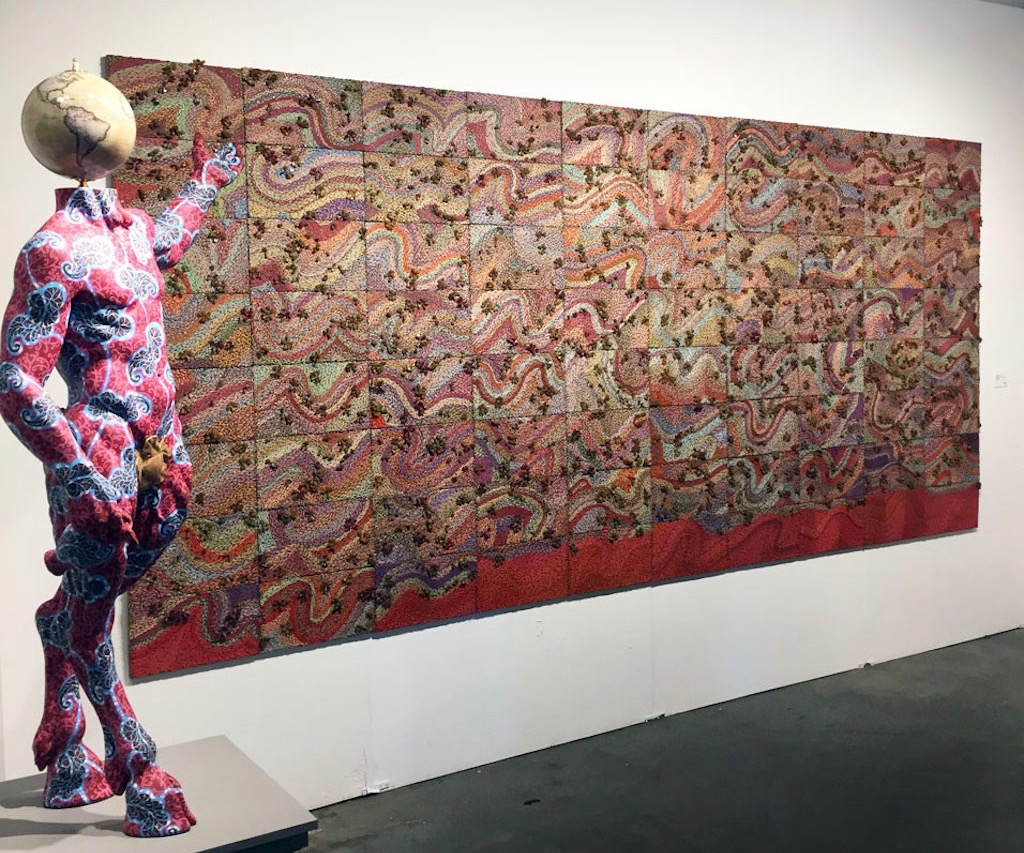
The James Cohan Gallery booth at 1-54.
KATHERINE MCMAHON
Inside the fair, dealers were showing work by a mix of formidable African artists and emerging figures with little familiarity to most in the U.S. The booth for New York’s James Cohan Gallery had a towering sculptural work by Yinka Shonibare MBE beside a pair of large wall works by Elias Sime, whose intricate weavings of discarded wire and electrical components turn otherworldly. One titled Tightrope: non-essential speed (2017) was priced at $120,000.
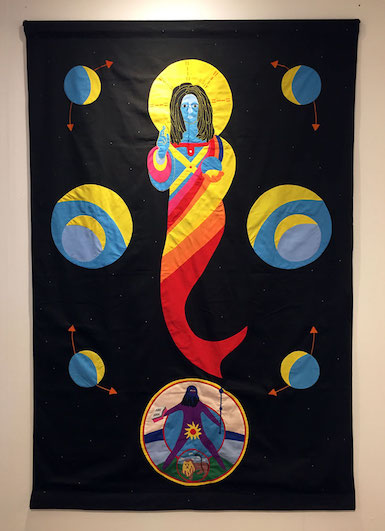
Emo de Medeiros, Transatlantica (…for overseas prayers shall be heard), 2018, at 50 Goldborne booth.
KATHERINE MCMAHON
“It is unusual for an international gallery to do such a specific kind of fair,” dealer Jane Cohan said of her space’s first time participating in 1-54, “but there’s a fantastic energy and interest in the artists and galleries being shown. It’s important to support getting unheard voices from Africa out there and to join voices that have more international careers with those who are underrepresented.”
The booth for 50 Goldborne gallery from London featured large textile wall hangings with boldly colored figurations and hidden chips that activate smartphone technology by Emo de Medeiros, who lives and works in Paris and Benin. One of them, a 2018 work titled Transatlantica (…for overseas prayers shall be heard), borrowed its face from Leonardo da Vinci’s Salvator Mundi and placed it on the body of a mermaid—“in West Africa, a figure of unity,” said gallery director Pascale Revert. To activate it, she held up her phone to connect with a chip secreted between sheets of fabric that transmitted a message about the nature of truth. “You need an Android phone—an iPhone doesn’t work,” she said of the technology. “When we sell the work”—priced at $17,000—”we sell it with a phone so people can play with it straightaway.”
Beguiling sculptures by Terrence Musekiwa featured in the booth for Catinca Tabacaru Gallery, which has locations in Zimbabwe and New York. “He has been sculpting since he was six years old,” Tabacaru said of the artist, now 27. “He’s able to create these very expressive faces, and then the rest of the body acts as a profile of what’s being brought to and thrown away in Zimbabwe.” Limbs were fashioned from pre-formed plastic bottles that had been from China but marked as too blemished to use, and other materials included wire, glue, and mud. Two small sculptures were priced at $4,000, and a larger one was available for $7,000.
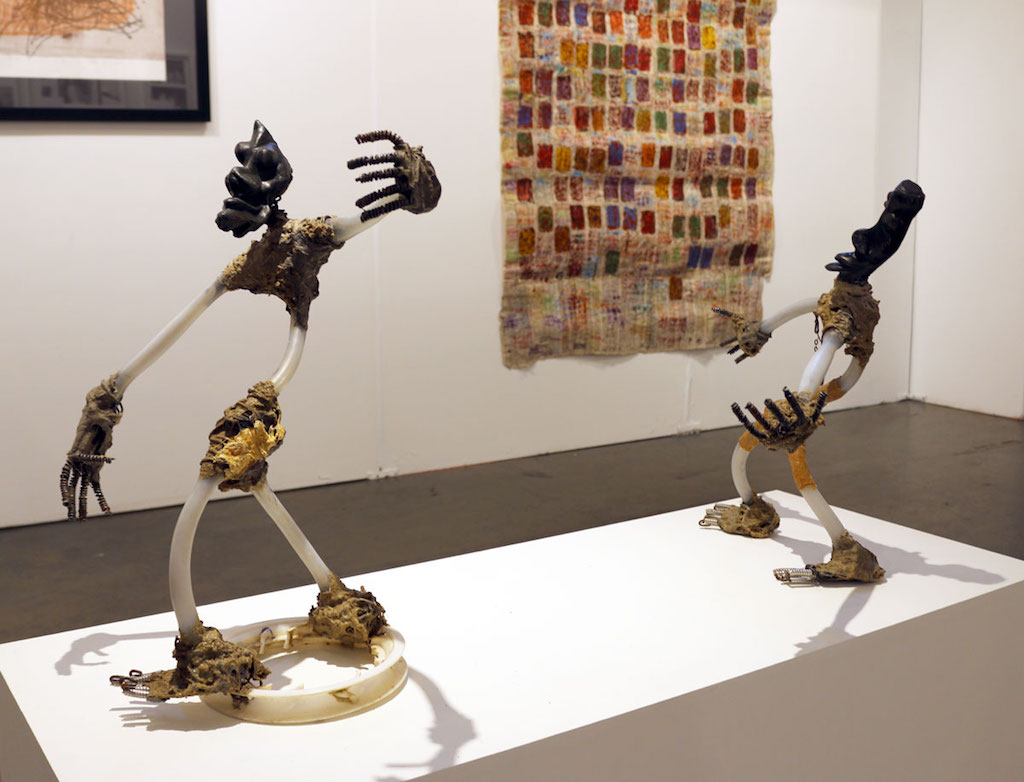
Catinca Tabacaru Gallery’s booth at 1-54.
KATHERINE MCMAHON
London’s Sulger-Bovell Gallery, which is participating in its first 1-54 fair in New York after buying into past ones in London and Marrakech, is presenting work by artists including the Senegalese Soly Cissé and the South African Ralph Ziman, whose SPOEK 1 tank sculpture outside is accompanied by related large photographs priced at $7,000–$10,000. Galerie Cecile Fakhoury, from Abidjan, the Ivory Coast, has a pair of bewitching works on paper by Sedikou Oukpedjo, including one with a ghostly blue figure holding a bleary red gas can. The works by the artist, from the West African nation of Togo, are priced €7,500–€11,000, or about $8,900–$13,200.
Retro Africa gallery, from the Nigerian capital Abuja, is participating in its first 1-54 fair with a booth devoted to paintings, sculpture, and photography. After meeting El Glaoui at Art x Lagos fair, “it seemed like a great opportunity to give our artists some reach and exposure, and bring them to a different group of people who would interpret the work differently as well,” said Abdullahi Umar, a cofounder and director of the gallery. “We could share perspectives.”
Katharina Maria Raab brought her namesake gallery to 1-54 for her first time as well. In Berlin, where she’s based, “We don’t have a dialogue between different artists,” she said. “What I’m trying to do with the gallery is establish a dialogue between European and Moroccan artists and others from the Middle East and put them in close contact.” In her booth are hushed and powerful works on paper by Mahi Binebine, a Moroccan artist whose paintings, the gallerist said, consider questions like “Who can I trust? Are those people hugging or wrestling? How are people erased?”
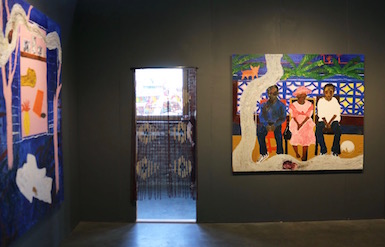
Gideon Appah’s site-specific booth for Gallery 1957.
KATHERINE MCMAHON
An especially beckoning booth, with a beaded curtain to walk through for entry, was organized by Gallery 1957 from Accra, Ghana, to evoke the feeling of a Ghanaian living room. All the work was made for the site-specific presentation by Gideon Appah, whose paintings are interlaid with old family photographs to pay tribute to his grandmother. So too are objects arranged all around, such as an old TV (with VHS tapes) and a tattered couch. At the heart of it is “the idea of memory and the afterlife and how we hold on to people,” said Victoria Cooke, director of Gallery 1957, which was founded two years ago to focus on work by West African artists and others from the diaspora.
Also intriguing are offerings on a cart in the booth: bottles of old spirits of the kind of that can be imbibed, including a Ghanaian brand of Orijin bitters labeled as a “spirit drink with herbal extracts.” Cooke made it seem like sips can be made available, so consider communing if the desire strikes.
[ad_2]
Source link

